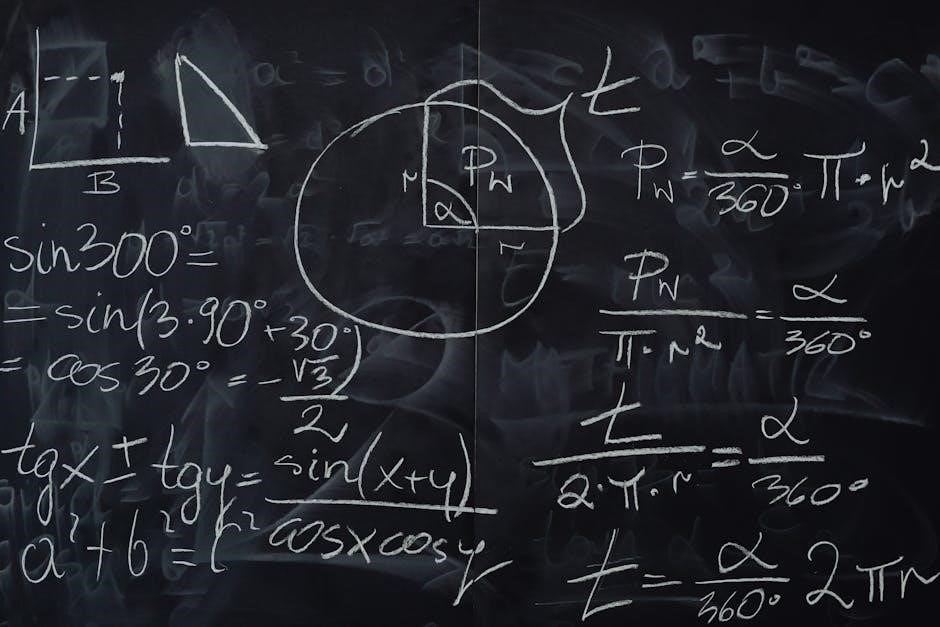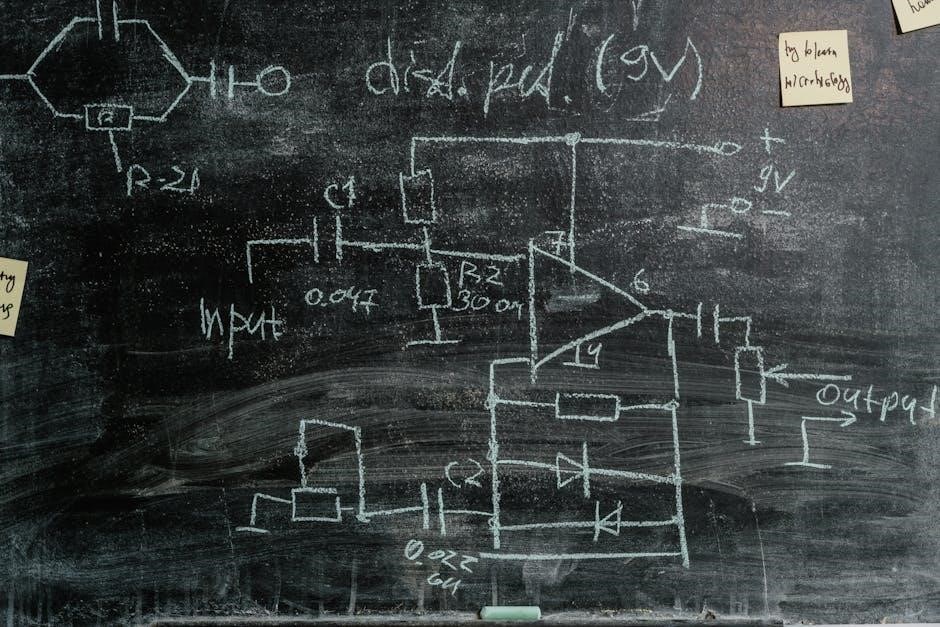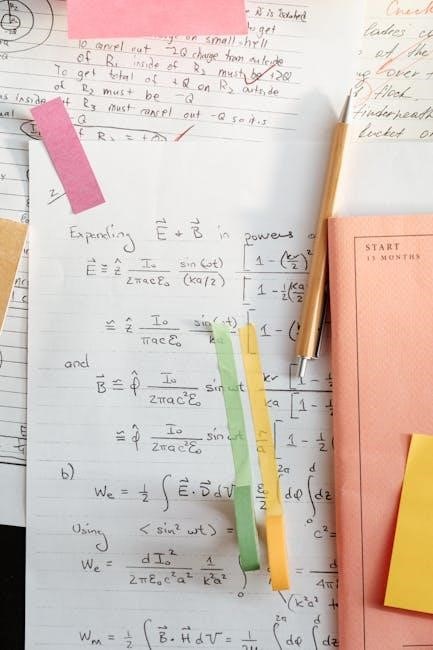Systems of equations are a fundamental concept in algebra, enabling the solution of multiple variables through various methods. Worksheets provide essential practice for mastering these skills.
1.1 What Are Systems of Equations?
A system of equations consists of two or more equations with the same variables, requiring the simultaneous determination of variable values that satisfy all equations. These systems are fundamental in algebra, enabling the solution of complex problems involving multiple unknowns. They can be solved using methods like substitution, elimination, or graphing, and are widely applied in various fields, including science, engineering, and economics. Worksheets provide structured practice to master these essential algebraic concepts effectively.
1.2 Importance of Learning Systems of Equations
Mastering systems of equations enhances problem-solving and algebraic skills, crucial for advanced mathematics. It fosters logical thinking and the ability to model real-world scenarios. These skills are essential in science, engineering, and economics. Regular practice with worksheets reinforces concepts, builds confidence, and prepares learners for complex challenges. Understanding systems of equations is vital for developing a strong mathematical foundation, enabling learners to approach problems methodically and solve them efficiently in various academic and professional contexts.

Types of Systems of Equations
Systems of equations can be classified into linear and nonlinear, as well as homogeneous and heterogeneous, based on their structure and the presence of constants.
2.1 Linear vs. Nonlinear Systems
Linear systems consist of equations where variables are of the first degree, while nonlinear systems involve variables raised to higher powers or multiplied together. Linear systems typically have straight-line graphs and consistent solutions, while nonlinear systems can have multiple or no solutions. Understanding this distinction is crucial for choosing the appropriate method to solve the system, as techniques like substitution or elimination are more effective for linear equations, whereas nonlinear systems may require advanced methods or numerical solutions.
2.2 Homogeneous vs. Heterogeneous Systems
Homogeneous systems consist of equations where all constant terms are zero, often leading to at least one trivial solution. In contrast, heterogeneous systems have non-zero constants, requiring specific conditions for solutions. Homogeneous systems typically have infinitely many solutions or are dependent, while heterogeneous systems may have one unique solution or no solution. Recognizing this distinction aids in selecting appropriate solving strategies and understanding the nature of solutions in various algebraic problems.

Methods for Solving Systems of Equations
Common methods include substitution, elimination, and graphical approaches. Each technique offers unique advantages, allowing learners to solve systems effectively and build problem-solving confidence through practice.
3.1 Substitution Method
The substitution method involves solving one equation for a variable and substituting this expression into the other equation. This step-by-step approach simplifies systems by reducing them to a single variable, making them easier to solve. Worksheets often include exercises that focus on this method, helping learners master algebraic manipulation and substitution techniques. Regular practice builds confidence and fluency in solving systems of equations effectively.
3.2 Elimination Method
The elimination method is a powerful technique for solving systems of equations by eliminating one variable at a time. This is achieved by adding or subtracting the equations, making it easier to solve for the remaining variable. Worksheets often include a variety of problems that require the elimination method, allowing learners to practice and refine their skills in a structured manner. Regular practice with these exercises helps build confidence and fluency in solving systems of equations effectively.
3.3 Graphical Method
The graphical method involves plotting the equations of a system on a coordinate plane to find their intersection point, which represents the solution. This visual approach is particularly intuitive for understanding how systems of equations work. Worksheets often include graphing exercises that help learners identify solutions by analyzing the lines’ intersection. Regular practice with graphical methods enhances problem-solving skills and provides a clear, visual understanding of systems of equations, making complex concepts more accessible and engaging for students.

Benefits of Using Worksheets for Practice
Worksheets offer structured practice, improving problem-solving skills and reinforcing algebraic concepts. They provide a clear path to mastering systems of equations through guided exercises and examples.
4.1 Reinforcing Concepts and Skills
Worksheets provide structured practice, reinforcing understanding of systems of equations. They offer a variety of exercises, from substitution to elimination methods, helping students build proficiency. By solving multiple problems, learners solidify their grasp of algebraic manipulation and problem-solving strategies. Regular practice through worksheets enhances accuracy and confidence, preparing students for more complex mathematical challenges. Clear examples and guided exercises ensure a strong foundation, making worksheets an essential tool for mastering systems of equations effectively.
4.2 Identifying Common Mistakes
Worksheets help students recognize and correct common errors in solving systems of equations. Typical mistakes include algebraic manipulation errors, misinterpreting graphs, and overlooking special cases. By reviewing worked examples and comparing answers, learners can pinpoint where they went wrong. Detailed solution keys enable self-assessment, fostering a deeper understanding of problem areas. This focused practice helps students develop careful habits and improve accuracy, ensuring they avoid recurring mistakes in future problems.
4.4 Building Problem-Solving Confidence
Consistent practice with systems of equations worksheets helps students build confidence in their problem-solving abilities. By mastering various problem types and understanding the underlying concepts, learners gain a sense of accomplishment. Recognizing progress through correct answers reinforces their belief in their skills. This confidence enables them to approach more complex problems with a positive mindset, fostering resilience and a growth mindset in mathematics.

Key Features of a Good Systems of Equations Worksheet
A good systems of equations worksheet should include clear instructions, examples, varied problem types, and answer keys to enhance learning and assessment. Problems are well-organized.
5.1 Variety of Problem Types
A good worksheet should offer diverse problem types, such as linear and nonlinear systems, to cater to different learning needs. Including word problems, graphical interpretations, and real-world applications enhances understanding. Problems should range from simple to complex, allowing students to gradually build proficiency. Mixing homogeneous and heterogeneous systems ensures comprehensive practice. This variety helps students apply concepts in various contexts, making their learning experience richer and more engaging. It also prepares them for different challenges they may encounter in higher-level mathematics.
5.2 Clear Instructions and Examples
Clear instructions and examples are crucial for effective learning. Worksheets should provide step-by-step guidance for solving systems of equations, ensuring students understand each method. Including worked-out examples helps learners grasp problem-solving strategies and algebraic manipulations. Visual aids, such as graphs or charts, can further clarify concepts. Instructions should be concise yet detailed, avoiding ambiguity. This clarity enables students to follow along confidently, reducing confusion and enhancing their ability to apply the techniques independently. Well-structured examples also serve as valuable references for review and practice.
5.3 Included Answer Keys
Included answer keys are essential for verifying solutions and assessing understanding. They allow students to check their work independently, fostering self-directed learning. Answer keys also help identify common errors, enabling targeted practice. For educators, they save time and provide a consistent reference for grading. Clear and accurate answer keys enhance the effectiveness of worksheets, ensuring learners can confidently gauge their progress and mastery of systems of equations. This feature is invaluable for both students and teachers.

Creating Effective Systems of Equations Worksheets
Effective worksheets incorporate clear instructions, real-world applications, and varied problem types. They should align with skill levels and include technology integration for enhanced engagement and understanding.
6.1 Tailoring to Different Skill Levels
Effective worksheets cater to diverse skill levels by adjusting problem complexity and incorporating visual aids. Beginners benefit from simplified equations, while advanced learners tackle nonlinear systems. Including technology integration, such as graphing calculators, enhances engagement. Clear instructions and gradual difficulty ensure a smooth learning curve, building confidence and fluency. This approach allows educators to meet the needs of all students, fostering a comprehensive understanding of systems of equations.
6.2 Incorporating Real-World Applications
Engaging worksheets connect systems of equations to real-world scenarios, such as budgeting, physics, or resource allocation. Practical examples help students see the relevance of algebra in everyday life. Problems involving mixtures, motion, and economics illustrate how equations model real situations. This application enhances understanding and motivation, making abstract concepts more tangible and meaningful for learners at all skill levels.
6.3 Using Technology to Generate Problems
Technology enhances worksheet creation by generating diverse systems of equations problems. Tools like online solvers and educational software can produce customizable equations. Graphing calculators and apps visualize solutions, aiding understanding. Automated problem generators ensure variety and relevance, while interactive platforms provide instant feedback. This integration of technology makes practice engaging and efficient, catering to different learning styles and skill levels dynamically.

Common Mistakes to Avoid
Common errors include algebraic manipulation mistakes, misinterpreting graphs, and overlooking special cases. Students often miscalculate during substitution or elimination, leading to incorrect solutions. Always double-check work and use answer keys to verify accuracy for better understanding and mastery of systems of equations.
7.1 Errors in Algebraic Manipulation
One of the most common mistakes when solving systems of equations is incorrect algebraic manipulation. Students often mismanage signs, mishandle coefficients, or incorrectly distribute terms, leading to erroneous solutions. For instance, forgetting to apply operations to both sides of an equation or incorrectly expanding brackets can throw off the entire solution process. To avoid these errors, it is essential to work methodically, double-check each step, and verify solutions by substituting them back into the original equations. Regular practice with worksheets helps identify and correct these algebraic pitfalls, ensuring a stronger grasp of systems of equations.
7.2 Misinterpreting Graphs
Misinterpreting graphs is a common issue when solving systems of equations. Students often incorrectly identify intercepts or misjudge the number of solutions based on graph intersections. For example, assuming two lines intersect at only one point or failing to recognize parallel lines (no solution) or coinciding lines (infinite solutions) can lead to errors. To avoid this, it is crucial to carefully analyze graph details and verify solutions algebraically. Worksheets with graphing exercises help improve interpretation skills and reduce such mistakes.
7.3 Overlooking Special Cases
Overlooking special cases, such as parallel lines or dependent systems, is a frequent mistake when solving systems of equations. Students may assume every system has a unique solution, but cases like no solution (parallel lines) or infinite solutions (identical equations) often go unnoticed. Identifying these requires careful examination of coefficients and constants. Worksheets with special case problems help students recognize patterns and apply appropriate methods, ensuring they don’t overlook these critical scenarios in their solutions.

Advanced Topics in Systems of Equations
Exploring systems with more variables, inequalities, and higher-level applications expands problem-solving skills, preparing for complex mathematical challenges in academics and real-world scenarios effectively.
8;1 Systems with More Than Two Variables
Systems involving more than two variables introduce greater complexity, requiring advanced techniques such as matrix operations or substitution methods. These systems are common in real-world applications like engineering and economics, where multiple interdependent factors must be analyzed. Solving them enhances analytical skills and prepares learners for broader mathematical challenges, emphasizing the importance of precise algebraic manipulation and organized problem-solving strategies to handle intricate relationships between variables effectively.
8.2 Systems Involving Inequalities
Systems involving inequalities extend beyond traditional equations by incorporating constraints such as ≤ or ≥. These systems often represent real-world scenarios where variables are bounded, requiring solutions within specific ranges. Unlike equations, inequalities can yield multiple or infinite solutions, necessitating a graphical or analytical approach to identify the feasible region. Worksheets focusing on such systems help learners grasp the transition from equality to inequality-based problem-solving, enhancing their ability to interpret and apply constraints effectively in various mathematical and real-world contexts.
8.3 Applications in Higher Mathematics
Systems of equations form the foundation for advanced topics in higher mathematics, such as linear algebra and calculus. They are essential for solving complex problems involving vectors, matrices, and differential equations. These systems also play a crucial role in optimization techniques and modeling real-world phenomena, such as population growth and economic forecasting. Worksheets emphasizing these applications help bridge the gap between theoretical concepts and practical problem-solving, preparing students for more challenging mathematical pursuits.
Using Technology to Solve and Practice Systems of Equations
Technology enhances the solving and practice of systems of equations through graphing calculators, online solvers, and educational software, providing interactive tools and real-time feedback for students.
9;1 Graphing Calculators
Graphing calculators are powerful tools for visualizing and solving systems of equations. They allow students to plot equations, identify intersections, and explore solutions graphically. Features like zoom and trace enable detailed analysis, while built-in algebraic solvers provide numerical answers. These devices are especially useful for verifying solutions and understanding the relationship between equations. Many calculators also support advanced functions, making them invaluable for both practice and complex problem-solving in mathematics education.
9.2 Online Solvers and Tools
Online solvers and tools provide instant solutions to systems of equations, offering step-by-step explanations and graphical representations. These resources are accessible anywhere with internet connectivity, making them ideal for homework and self-study. Many tools, like equation solvers and graphing software, allow users to input equations and receive detailed solutions. They are particularly useful for checking work, exploring problem variations, and gaining a deeper understanding of complex systems. These tools enhance learning by providing interactive and visual approaches to problem-solving.
9.3 Educational Software
Educational software offers interactive tools for solving systems of equations, providing step-by-step solutions and visual representations. Programs like Mathematica and online platforms enable students to explore equations dynamically, enhancing understanding. These tools often include practice exercises and solutions, allowing learners to test their skills and review mistakes. They are invaluable for self-study, offering flexibility and accessibility. By leveraging technology, students can deepen their grasp of systems of equations in an engaging and effective manner.

Real-World Applications of Systems of Equations
Systems of equations are widely used in science, engineering, and economics to model complex relationships, optimize resources, and solve practical problems, making them indispensable in real-world scenarios.
10.1 Science and Engineering
Systems of equations are pivotal in science and engineering for modeling complex relationships. In physics, they solve problems involving forces and motion, while in engineering, they optimize system designs. Biologists use them to study population dynamics, and chemists apply them to balance reactions. These equations enable precise calculations and predictions, making them indispensable in real-world applications. Graphing calculators and software tools often aid in solving these systems, ensuring accuracy and efficiency in scientific and engineering problem-solving scenarios.
10.2 Economics and Finance
Systems of equations are essential in economics and finance for analyzing market trends, supply-demand relationships, and investment portfolios. They model complex interactions between variables like inflation, unemployment, and GDP. Worksheets provide practical exercises to solve real-world financial problems, such as calculating interest rates or predicting market behaviors. These tools enhance understanding of economic principles and improve decision-making skills for professionals and students alike, ensuring accurate and informed financial analysis.
10.3 Everyday Problem Solving
Systems of equations are invaluable in everyday problem-solving, from budgeting and financial planning to managing resources efficiently. Worksheets help individuals apply mathematical concepts to real-life scenarios, such as adjusting recipes, scheduling tasks, or optimizing household expenses. By practicing these problems, learners develop practical skills to tackle everyday challenges with clarity and precision, making math a useful tool for decision-making and improving overall problem-solving abilities in various aspects of life.

Selecting the Right Worksheet for Your Needs
Choosing the right worksheet involves aligning it with your skill level, learning objectives, and specific needs. Ensure it includes varied problems, clear instructions, and answer keys for effective practice and understanding.
11.1 Assessing Your Current Skill Level
Assessing your current skill level is crucial for choosing the right worksheet. Start by identifying your strengths and weaknesses in solving systems of equations. Review basic concepts and practice fundamental problems to build confidence. Use textbooks or online resources to gauge your understanding. Track your progress and focus on areas where you struggle. This self-evaluation ensures you select worksheets that challenge you appropriately, helping you grow step-by-step in mastering systems of equations.
11.2 Setting Clear Learning Goals
Setting clear learning goals helps you stay focused and motivated. Define what you want to achieve, such as mastering substitution or elimination methods. Break down larger objectives into smaller, manageable tasks. Prioritize areas where you need improvement and allocate time for practice. Use worksheets that align with your goals, starting with basic problems and progressing to more complex ones. Regularly track your progress to ensure steady improvement and adjust your goals as needed.
11.3 Utilizing Additional Resources
Supplement your learning with textbooks, online tools, and educational software. Textbooks offer detailed explanations and practice problems, while online solvers provide step-by-step solutions. Utilize graphing calculators to visualize systems and verify answers. Engage with video tutorials and interactive exercises to deepen understanding. Join study groups or forums for peer support. Combine these resources with worksheet practice to reinforce concepts and track progress effectively. Leveraging diverse materials ensures a well-rounded mastery of systems of equations.
Final Thoughts on Mastering Systems of Equations
Consistent practice, conceptual understanding, and problem-solving skills are key to mastering systems of equations. Apply knowledge to real-world challenges for lasting proficiency.
12.1 The Importance of Regular Practice
Regular practice is crucial for mastering systems of equations. Worksheets provide structured exercises to build fluency and understanding. Consistent practice helps develop problem-solving skills, reinforces concepts, and improves algebraic manipulation. By solving various problem types, students enhance their ability to apply methods like substitution and elimination effectively. Regular practice also identifies common mistakes, allowing for targeted improvement. Over time, consistent effort leads to confidence and mastery, making complex systems more approachable and manageable.
12.2 Seeking Help When Needed
Seeking help when struggling with systems of equations is essential for understanding and progress. Utilize online solvers, educational software, or tutoring resources to clarify concepts. Collaborating with peers or instructors can also provide new insights and strategies. Asking questions and reviewing challenging problems ensures gaps in knowledge are addressed. Open communication fosters a supportive learning environment, enabling students to overcome obstacles and build confidence in solving complex systems effectively.
12.3 Applying Knowledge to Future Challenges
Mastering systems of equations equips students with analytical and problem-solving skills essential for future academic and real-world challenges. These skills are foundational for advanced mathematics, science, and engineering. By practicing with worksheets, students develop the ability to approach complex problems methodically. This knowledge enables them to model real-world scenarios, optimize solutions, and think critically in interdisciplinary contexts. Applying these concepts to future challenges fosters innovation and prepares learners for lifelong problem-solving in various fields.
